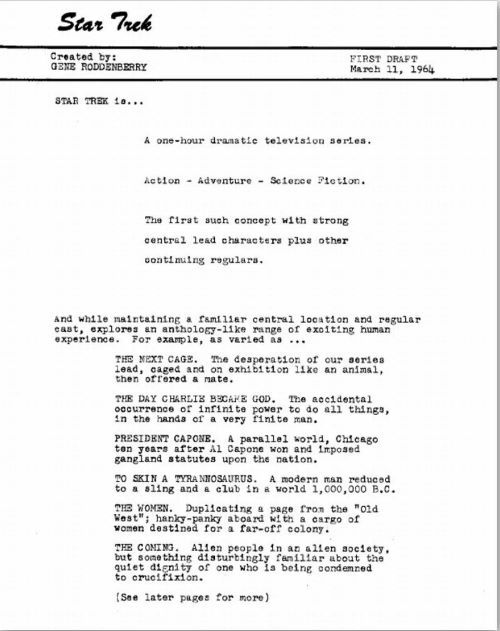That first pitch, called "Star Trek is..." described the show as being a one-hour dramatic television series, however, if the show had gone to air as initially conceived, it would have left us without many of the things we know and love today.
These are the voyages of the Star Ship Yorktown…

In the initial pitch for the show, the ship the action centred upon was to be called the SS Yorktown, a name chosen by Roddenberry to honour the World War II ships of the Pacific. Whilst an air force bomber pilot himself, Roddenberry wanted to honour the actions of the pacific fleet, whose actions in the Pacific turned the tide of the war. These ships included the aircraft carrier USS Yorktown.
Ultimately the decision would be taken to use the name of the Yorktown's sister-ship, the USS Enterprise. During a 1973 interview between Scott Arthur and Gene Roddenberry, Roddenberry explained that he had been impressed by the history of the USS Enterprise, especially with her action at the Battle of Midway saying "I had always considered her a very heroic ship and decided to use the name." Interestingly the USS Yorktown was sunk at the same battle.
Whilst the Enterprise would end up being the name chosen, the Yorktown would still be seen in several episodes and as one of the ships stripped of power by the "Whale Probe" in Star Trek IV: The Voyage Home.
Captain April on deck…
The initial pitch for the show didn’t include Captain James T. Kirk, but rather another captain by the name of Captain Robert April. There was no Captain Christopher Pike either. Captain April shared many of the traits we would know and love however, in an excerpt from the original pitch, Captain April is described as,
“A space-age Captain Horatio Horn-blower”, lean and capable both mentally and physically.
A colorfully complex personality, he is capable of action and decision which can verge on the heroic — and at the same time lives a continual battle with self-doubt and the loneliness of command."
Fascinating…
Spock, however, ended up being far closer to the initial concept conceived by Roddenberry. Although there were some very stark differences. Whilst he was a half-alien, in the initial concept, he was suggested to be half-Martian with reddish-toned skin, rather than the green-blooded half-Vulcan we know today. His slightly pointed ears were included in the initial concept, so at least that famous feature of Spock made it through the initial cut.
Rocket me up, Scotty…
Whilst there were no transporters in the initial pitch, Roddenberry understood that landing something the size of the aircraft carrier on multiple alien planets would not only be technically very challenging to shoot, but would likely blow the entire budget for the show in just a couple of scenes. To avoid this financial constraint, the decision was taken to land on planets using a “Recon Rocket Vehicle”, with the audience viewing the action through monitors called “telescreens”. Ultimately this was refined further to become the transporters we are familiar with today.
A wealth of plot ideas, where nothing went to waste.
In just 16 pages Roddenberry was able to create over 20 unique plot lines, many of which made it into either the original series, such as the show’s original pilot episode called “The Cage”, or in later series including several used in The Next Generation, including a pitch for an episode called “Infection” where a crew member becomes impregnated by an alien lava – an idea which went onto become the episode “The Child” in TNG.
The birth of the Federation
Whilst there were many changes after the initial pitch was made, it was ultimately successful and picked up by Desilu Productions, Inc. The original pilot episode "The Cage" would be screened to NBC in February 1965, and be rejected by the broadcaster, who demanded a new pilot episode be made. The series would ultimately go to air on television in the USA and Canada in September of 1966 with the episode "Where no man has gone before".
Regardless of which episode came first, the name of the ship, or the name of its Captain - every Trek fan can trace their love of this show back to this initial idea, and the document that started it all 60 years ago today.
So, from this fan - Happy 60th anniversary Star Trek!
What did you think of this article? Are there parts of Star Trek you could not imagine being any other way? Tell us in the comments below.
WRITTEN BY WoorLord
EDITED BY WoorLord
IMAGES SOURCED FROM Memory-Alpha.com -Memory-Alpha.com - Memory-Alpha.com


